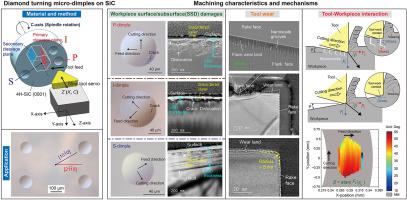International Journal of Machine Tools and Manufacture ( IF 14.0 ) Pub Date : 2023-07-31 , DOI: 10.1016/j.ijmachtools.2023.104063 Weihai Huang , Jiwang Yan

|
Single-crystal silicon carbide (SiC) is one of the most attractive materials for electronics and optics but extremely difficult to cut owing to its hard and brittle properties. While in previous studies, the focus has been placed on machining flat surfaces, in this study, the mechanisms of tool-workpiece interaction in cutting curved microstructures on 4H–SiC (0001) were explored through the ultraprecision diamond turning of micro-dimples. The surface/subsurface of both machined workpieces and used diamond tools were characterized, and the machining characteristics, such as chip formation and cutting forces, were also investigated. It was found that microcracks occurred easily in the feed-in/cut-in area of the dimples, which is caused by a large friction-induced tensile stress due to a large thrust force. The dimples located on the secondary cleavage directions <10−10> (S-dimples) were easy to produce crack-free surfaces, while the dimples located on the primary cleavage directions <−12−10> (P-dimples) were very prone to cause cracks on surfaces, even though the chips were formed in a ductile mode. The dimples located on the in-between direction (I-dimples) were moderately prone to surface cracking. It was also found that although the S-dimple has a crack-free surface, it has the thickest subsurface damage (SSD) layer containing a disordered layer, dislocations, and stacking faults; the SSD layer of the P- and I-dimples do not contain stacking faults; and the SSD layer of the I-dimple is the thinnest. Flank wear with nanoscale grooves on the diamond tool was significant without edge chipping and diamond graphitization detected. By optimizing the cutting conditions, a crack-free micro-dimple array was fabricated with nanometric surface roughness. The findings from this study provide guidance for the manufacture of curved SiC parts with high surface integrity, such as molds for replicating microlens arrays and other freeform surfaces on glass.
中文翻译:

弯曲微结构单晶 SiC 超精密金刚石车削中刀具与工件相互作用的机制
单晶碳化硅 (SiC) 是电子和光学领域最具吸引力的材料之一,但由于其硬而脆的特性,极难切割。之前的研究重点是加工平面,而本研究通过微凹坑的超精密金刚石车削探索了在 4H-SiC (0001) 上切削弯曲微结构时刀具与工件相互作用的机制。对已加工工件和所用金刚石刀具的表面/亚表面进行了表征,并研究了切屑形成和切削力等加工特性。研究发现,在凹坑的进给/切入区域容易出现微裂纹,这是由于大的推力导致的大的摩擦拉应力造成的。延性模式。位于中间方向的凹痕(I-凹痕)较容易出现表面裂纹。研究还发现,虽然S型韧窝表面无裂纹,但它具有最厚的次表面损伤(SSD)层,其中包含无序层、位错和堆垛层错;P-和I-凹坑的SSD层不包含堆垛层错;I-dimple的SSD层最薄。金刚石刀具上带有纳米级凹槽的后刀面磨损很明显,但没有检测到边缘碎裂和金刚石石墨化。通过优化切削条件,制造出具有纳米级表面粗糙度的无裂纹微凹坑阵列。这项研究的结果为弯曲的制造提供了指导具有高表面完整性的 SiC 零件,例如用于在玻璃上复制微透镜阵列和其他自由曲面的模具。



























 京公网安备 11010802027423号
京公网安备 11010802027423号